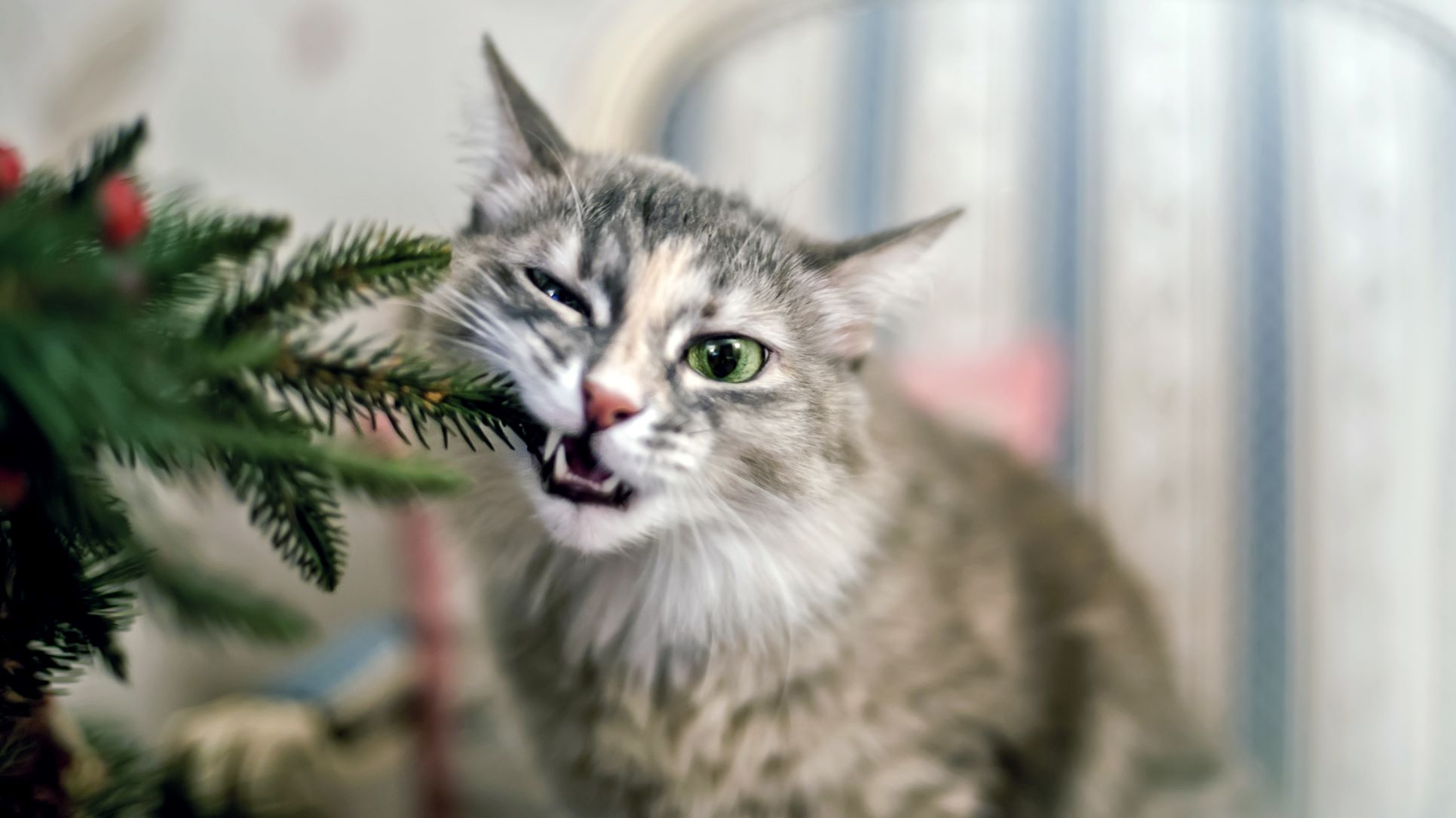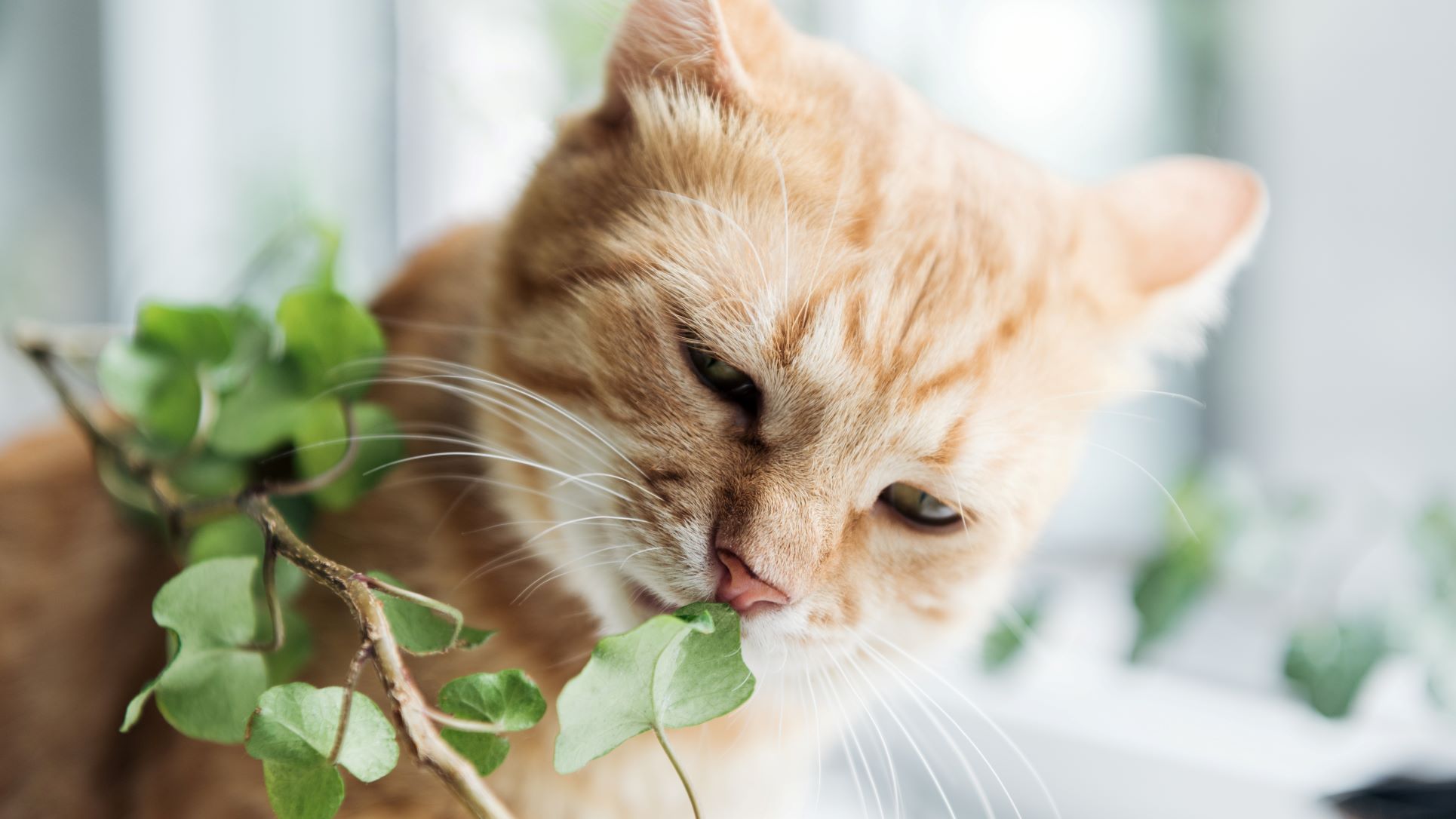How to stop a cat from eating plants
Want to keep your indoor jungle but need to know how to stop a cat from eating plants? We have all the lowdown on this

How to stop your cat from eating plants is sometimes overlooked in the home (until the situation occurs), however, it’s important to be informed on this topic as sadly, a plethora of plants are toxic to cats. A quick lick or nibble can result in your pet becoming unwell or in a life-threatening condition.
Each plant and season brings different poisonous elements, for example, some toxic plants are only available in the summer whilst others are winter plants. In some cases, it is the leaves that are dangerous, in others, it is the bulb, seeds, or stems of the plant. The signs and symptoms your cat may exhibit after ingestion of harmful houseplants are wide, which we will look at in more detail in just a moment, but this topic does raise the question of, if cats are instinctual beings (which they are) then why would they eat noxious houseplants in the first place?
To ensure your cat is not hungry, leading your friendly feline to try out your plants and greenery, check out our guide to the best dry cat food. It is also worth checking out options for cat-safe houseplants, to put your mind at ease.
Why does my cat keep eating my houseplants?
According to International Cat Care, poisoning of cats by toxic plants is rare and it is often kittens and younger nosey cats who end up in a spot of bother chewing and eating plants they shouldn't, as found in a study by MDPI. More often the interest and ingestion of plants is due to boredom. Wanting to play with dangling leaves
is tempting for felines or they might be attracted to the leaves blowing or
moving around and sometimes they just enjoy the taste! It's an answer we may never fully understand but if you suspect your cat has eaten a dodgy plant or is showing symptoms noted below, then this is the time to be concerned and escalate the situation by contacting your veterinarian immediately with your concerns.
If eating your houseplants is a new behavior or is a sudden onset, have your veterinarian check them over to rule out any underlying medical condition causing the unusual eating habit.
Get the best advice, tips and top tech for your beloved Pets
Should I worry about my cat eating plants?
Your cat devouring plants is absolutely something to be concerned about and needs to be prevented. As the Veterinary Poisons Information Service reports the tendency to eat house plants is increasing due to the number of cats being kept indoors for extended periods of time and or kept as indoor-only cats.
The risks of eating poisonous plants can vary causing a range of milder illnesses to death. As International Cat Care states, Deadly Nightshade for example can cause fatality from only a small amount being ingested.
Each plant has its own level of toxicity causing different results and symptoms but if you spot any of the following and have plants in your home or garden, call your veterinarian straight away or seek help.
- Drooling and salivating
- Breathing difficulties
- Weakness
- Increased urination
- Vomiting
- Diarrhea
- Incoordination
- Decreased eating
- Sneezing
- Fits or seizures
- Twitching
- Irritated skin, eyes, gums
- Collapse
- Increased drinking
- Lethargy, low energy and poor demeanor

What plants are toxic to cats?
There are a surprising number of houseplants (and outdoor plants) toxic to cats including those such as the Cheese Plant, Rubber Plant, Peace Lily, Lilies, Poinsettia, Ivy, Orchids, Money Tree, Yucca plants, Aloe, Fungi (mushrooms) and Marijuana.
The most effective way to check if a plant is toxic to your cat, and to give you as much information as possible on hand, is to consult one of the lists below detailing toxic plants in the USA and toxic plants in the UK, kindly provided by the American Society for the Prevention of Cruelty to Animals and the Cats Protection respectively.
You may wish to print out these lists (or screenshot a picture) and keep them to hand:
- Toxic plants to cats in the USA
- Toxic indoor plants to cats in the UK
- Toxic outdoor plants to cats in the UK
These lists may not be an exhaustive catalog of all possible toxic plants; therefore any concerns or suspicions should be immediately directed to your veterinarian as time is crucial. Alternatively in the USA, you can call the Animal Poison Control Centre or the Poison Helpline Line and in the UK you can join or call the Animal Poison Line
How to prevent your cat from eating houseplants?
The simplest advice is not to have any plants around the home as there isn’t a solution guaranteed to stop this behavior and is therefore imperative to do your homework first, so you can be sure you at least only have safe plants in the house.
Taking measures such as those suggested below gives you the opportunity to keep your cat safe whilst still keeping your flora.
1. Keep plants out of reach and inaccessible (remember cats are climbers and jumpers!) or separate from where your cats roam.
2. Ensure your cat has enough recreational activities to prevent boredom, scratching posts and toys for example provide entertainment.
3. Check your cat is being fed the correct amount of food daily to keep hunger at bay.
4. Make plants unappetizing or unappealing by spraying the plant POT with a white vinegar and water solution. This harms neither the plant nor your cat but deters your pet as they dislike the smell.
5. Pet-friendly bitter sprays can be used.
6. Burrow citrus peel in the soil. Cats detest the smell of citrus; however, care needs to be exercised as citrus itself is also toxic to cats. Therefore, citrus sprays, oils or solutions need to be avoided.
7. Surround the plants with items such as soda cans, foil, pebbles or sticky products to ward them off, as cats are averse to the noise and or feel of these items.
8. Provide cat grass or cat plants to offer your cat their own dedicated greenery or create a little cat indoor garden.
9. Fill empty spaces. A lone shelf with only one plant on it encourages their inquisitive nature to jump and play with the plant pot. If the shelf is full, they are less likely to partake in this behavior.
10. Offer catnip to arouse their senses!
11. Avoid punishing your cat; read our guide on how to discipline a cat.
Want more of your feline queries answered? Clue yourself up on how to play with a cat or find out the answer to the commonly asked question, why won’t my cat sleep?
Annaliese qualified as a veterinary nurse from Edinburgh and went on to attain a diploma in advanced veterinary nursing in surgery from London. Throughout this time, she worked in both small and mixed veterinary practices and gained head nurse status. Responsible for training other veterinary nurses she also ran the nursing department, nurse clinics, and patient care protocols.
She has looked after 1,000s of patients and owners and created new higher standard nursing regimes, whilst specializing in surgery and anesthesia. After being asked to co-author multiple veterinary nursing textbooks, Annaliese continued to write for further mainstream publications in the UK and USA and after twenty-plus years in both the veterinary and pet care professions, she hung up her scrub suit and now writes full-time.

